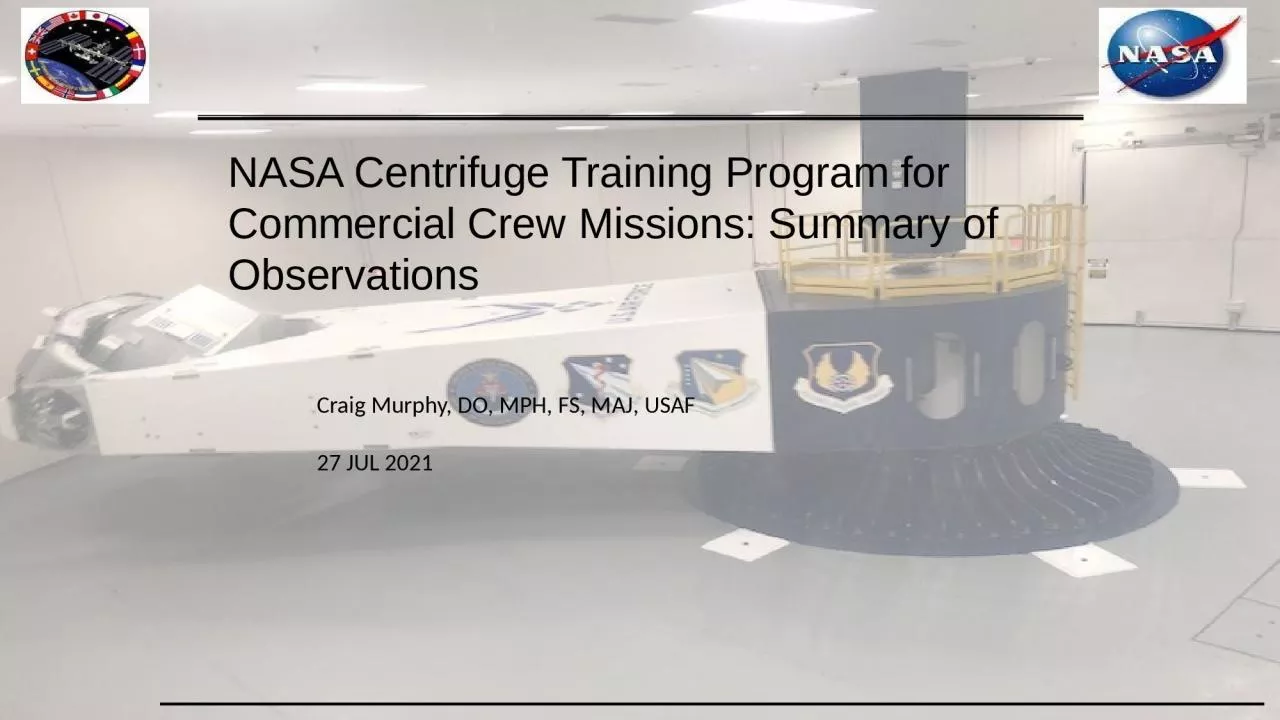

Craig Murphy DO MPH FS MAJ USAF 27 JUL 2021 Introduction The development of new Commercial Crew space vehicles returns NASA to capsule configurations with ascent and entry accelerations comparable to those of Apollo Gemini and Soyuz spacecraft ID: 1045485
Download Presentation The PPT/PDF document "NASA Centrifuge Training Program for Com..." is the property of its rightful owner. Permission is granted to download and print the materials on this web site for personal, non-commercial use only, and to display it on your personal computer provided you do not modify the materials and that you retain all copyright notices contained in the materials. By downloading content from our website, you accept the terms of this agreement.
1. NASA Centrifuge Training Program for Commercial Crew Missions: Summary of ObservationsCraig Murphy, DO, MPH, FS, MAJ, USAF27 JUL 2021
2. IntroductionThe development of new Commercial Crew space vehicles returns NASA to capsule configurations with ascent and entry accelerations comparable to those of Apollo, Gemini, and Soyuz spacecraft.The pivot away from the space shuttle configuration has necessitated new training updates to familiarize crewmembers, and most recently untrained commercial spaceflight participants (SFPs), with flight-like acceleration forcesTesting profiles were developed at Johnson Space Center (JSC) and Kennedy Space Center (KSC) and carried out at Wright-Patterson Air Force Base (WPAFB)
3. Human spaceflight, particularly critical phases of flight including takeoffs, landings, and some special maneuvers, expose capsule occupants to levels of acceleration (g-forces) several times that experienced by most humans on a day-to-day basisThe capsule configurations of current spacecraft, including the Soyuz and SpaceX Crew Dragon, expose occupants to primarily forces in the Gx, or chest-to-back, axis. Compared to Gz (head-to-toe) and Gy (side-to-side) humans tolerate Gx forces extremely well.Background
4. We developed a standardized centrifuge protocol with g-loads timed and sequenced to simulate the ascent, descent, and abort procedures, corresponding to peaks of roughly 3.5 and 4.5Gx, respectivelyPeak Gx periods were sustained for 120 seconds with 90-second rest periods between profiles.Touchscreen panels and flight similar hardware were mounted in appropriate positions to provide realistic manipulation challenges for participants as would be expected during an actual flight.Participants were evaluated and monitored by flight surgeons before, during, and after each spin to assess for adverse signs and symptoms. Results were collected using a standardized questionnaire and tabulated to identify any major risks or common findingsMethods
5. ResultsA total of 50 spins (n=50) were conducted. A handful of participants completed the protocols on multiple occasions over the course of the study, yielding a total of 40 unique participants. SymptomFrequencyChest Pressure28%Breathing Effort26%Reaching Difficulty26%Felt Warm22%Throat Discomfort20%Dizziness18%Nausea14%Cough10%Chest Discomfort8%Paresthesia8%Pain8%Blurry Vision6%
6. Results (post-spin)Participant ReportedSymptomFrequencyDizziness28%Unsteady Gait16%Nausea14%Felt Warm8%Flight Surgeon ExamAbnormal FindingFrequencyFall on Tandem Romberg4%Persistent Nystagmus4%
7. Perhaps the most important takeaway from the data is the fact that there were no serious adverse effects, and those symptoms that did occur were quite transient. Humans, whether trained or untrained, can tolerate sustained Gx exposure well without much training and without any special maneuvers or provisions. Discussion
8. DiscussionThe most common reported symptom of chest pressure is unsurprising. This is essentially part of the definition of Gx exposure, but for untrained SFPs it underscores the importance of good briefing materials, that address the top 3 observations, including breathing and reach difficulty
9. While the three most common observations could reasonably be considered normal experience in the centrifuge, the remaining symptoms should be acknowledged by the flight surgeon and prepared for. WarmthThroat discomfortDizzinessNauseaCoughDiscussion
10. This data adds to prior centrifuge runs and confirms good human tolerance of capsule operations at accelerations up to 4.5Gx with minimal adverse effects with minimal vibratory input.Novel symptoms, including warmth, dizziness, nausea, numbness, pain, and throat discomfort with or without cough, occurred with frequencies in the 10-20% rangeFew symptoms persisted after completion of the centrifuge profile, and even these were quite transientConclusions
11. Strengths/WeaknessesStrengthsCentrifuge profiles were able to closely mimic the onset and termination of acceleration forces as they would be experienced in flight.Crewmembers were able to actuate controls as would be expected during a mission Participants included untrained individuals who tolerated the protocols as well as trained astronauts and pilotsWeaknessesSmaller cohort limits power of any observed associations.The standard form used to assess for signs and symptoms was changed midway through data collection to address changes in SpaceX mission profile. Although very similar, the two forms are not identical
12. Special ThanksSam Testa (KSC)Jonathan Dory (JSC)Mark Dub (JSC)Supporting flight surgeons (JSC)Jonny Kim (CB)Dave Reyes (JSC)WPAFB Centrifuge StaffMax Dickey
13. ReferencesErnsting, John. Nicholson, Anthony. Rainford, David. Aviation Medicine third edition. Ch. 9. pp. 143-147. 1999.Golding, J.F. Stott, R.R. Objective and Subjective Time courses of Recovery From Motion Sickness Assessed By Repeated Motion Challenges. Journal of Vestibular Research. Vol. 7. No. 6. pp 421-428. 1997.Kumar, K. Vasantha. Norfleet, William T. NASA Technical Memorandum 104753: Issues on Human Acceleration Tolerance After Long-Duration Space Flight. Pp4-5. October 1992.Liston, Dorion B, Adelstein, Bernard. Stone, Leland. Onset of Positional Vertigo During Esposure to Combined G Loading and Chest-to-Spine Vibration. Case Report. Aviation Space Environmental Med. 2014.Roth, E.M. Teichner, W.G. Craig, R.L. Compendium of Human Responses to the Aerospace Environment. Ch. 7, 17-29. November 1968.Williams and Wilkins. Fundamentals of Aerospace Medicine second ed. Ch. 9. pp 254-256.